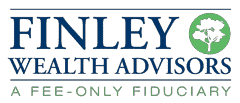- You are here:
- Home »
- Blog »
- Investment Advice »
- Cost Control: An Investor’s Greatest Investment
Cost Control: An Investor’s Greatest Investment

In the mid-1800s, is a collection of essays entitled “Conduct of Life,” Ralph Waldo Emerson observed, “Money often costs too much.” More than 150 years later, his words remain well worth heeding, as we focus on one of the most effective ways to enhance your wealth: aggressively eliminating unnecessary investment costs. The first step in managing investment expenses is to know where to find them. We divide them into two broad categories: transparent fees and hidden costs.
Transparent fees are readily apparent if you take the time to look for them:
Trading costs – When you buy or sell mutual funds, stocks, bonds, or other securities, you pay a broker a commission to place your trade. These commissions are typically disclosed in your trade confirmation statements.
Advisor support – If you are working with a fee-only advisor like Finley Wealth Management to help you build and maintain your investment portfolio, your fees are disclosed in your Asset Management Agreement.
If all investment costs were fully transparent, we could simply choose based on the cheapest rack rate and move on. Unfortunately, if you fail to account for the hidden “gotchas,” you are still losing real money in significant amounts. How significant? “Shedding Light on ‘Invisible’ Costs,” a study published in the January/February 2013 Financial Analysts Journal, helps us quantify that figure. According to the paper’s abstract (emphasis is our own), “The authors found that funds’ annual trading costs are, on average, higher than their expense ratio and negatively affect performance.” In other words, this and other evidence indicate that hidden costs can readily exceed those you see. And they only show up in the insidious form of lower returns or lost opportunities that are more difficult to measure but that impact your bottom line just as severely.
Here are a few of the more opaque ways investing can cost you more than is warranted:
So what are some of the steps we recommend for wisely managing your investment costs? Pay attention to the disclosed costs. An essential first step is to take the time to know what your funds’ published costs are, and whether they compare favorably to other similar opportunities. You’ll find these costs listed in the fund prospectus as fees such as expense ratios, 12b-1 fees, and sales charges/loads. You can also find them summarized by Morningstar, along with an assessment of how they compare to other similar funds. Generally, seek funds with comparably low expense ratios and no 12b-1 fees or sales charges. Reasonably priced expense ratios can be justified as fair compensation for a fund manager’s efforts (with Morningstar’s independent assessment being a good place to start in defining “reasonable”). Other disclosed costs tend to be thinly veiled kickbacks that compensate salespeople for recommending the fund to you, whether or not it’s in your best interest. These sorts of added costs do nothing to contribute to your end returns and should be avoided. Research your fund managers’ trading skills. As we described above, poor trading management shows up in diminishing returns rather than reflected in a fund’s fees. So how do you know? Cost-effective trading includes incorporating: A scientific approach, based on the academic evidence on how our markets have delivered long-term wealth. This helps minimize unnecessary trades and associated costs. Patience to be on the “cool” rather than the “hot” side of the trades. It’s only logical that those who are anxious to secure or unload a position won’t receive the best deals. Buying power, or being a big enough market player to command superior negotiating power. Take note of your fund managers’ commitment to client care. After all, a fund manager can charge a little or a lot to be excellent or poor at the job. The goal is to seek a fund manager who aggressively minimizes trading costs and demonstrably passes those cost savings on to you and other fund shareholders in the form of minimized expense ratios and higher long-term performance compared to appropriate benchmarks. Be your own best champion. The best fund manager in the world can’t save you from yourself. You must also avoid self-inflicted wounds, such as trading too frequently and without a deliberate plan, and failing to account for tax implications. Last but not least, we must address our own advisor fees. Helping you maintain cost-effective investments and investment habits is where we begin to earn our keep. That’s without even considering other values we seek to provide, such as building improved financial confidence into your busy life. In considering best practices for managing your investment costs, some steps may seem simple enough, such as comparing costs on Morningstar. Others are more challenging – such as conducting deep due diligence on fund manager performance and client-care metrics, assessing current academic insights, and maintaining a tax-efficient portfolio. There also is the challenge of adhering to your sensible, long-term strategy. There is ample evidence that investors who go it alone tend to underperform the very securities in which they’re invested by succumbing to hyperactive and ill-timed trading and its associated costs. In his November 2013 Wall Street Journal article, “How Investors Leave Billions on the Table,” columnist Jason Zweig said, “Over the past five years, Morningstar recently found, investors trailed all their funds by an annual average of 1.17 percentage points.” It pays to have an experienced guide by your side. Saying that we earn our fees is one thing. We’d rather show you. Before we commit to establishing an advisor relationship with you, we offer a complimentary analysis of your current portfolio, to help you understand what you’re currently paying, how your costs compare to appropriate benchmarks, and where we feel there is room for improvement. If you would like to receive our objective second opinion on your current portfolio, please be in touch with us today.
Your own trading activity – A poorly managed portfolio can spell a double-whammy against your end returns if you’re investing in inefficiently managed funds, and then you inefficiently manage your own use of those funds in your portfolio.
Tax impact – Similarly, a fund designed to be held within your taxable accounts can be managed with a sensitivity to minimize unnecessary realized taxes for you; plus you can further manage your taxable portfolio to do the same.
Markups/Markdowns – This is a nasty hidden expense particular to individual bond trades. When bonds are bought and sold, there is the equivalent of a “wholesale” versus “retail” price. The markup/markdown is the difference you pay above the “wholesale” price; that extra, typically hidden amount goes to the broker in addition to any disclosed commissions paid, which means you may unknowingly be paying a lot more than is necessary.Managing Investment Costs
Fund Managers’ Commitment To Client Care
Advisor Fees
Establishing An Advisor Relationship
About the Author Doug Finley
Douglas Finley, MS, CFP, AEP, CDFA founded Finley Wealth Advisors in February of 2006, as a Fiduciary Fee-Only Registered Investment Advisor, with the goal of creating a firm that eliminated the conflicts of interest inherent in the financial planner – advisor/client relationship. The firm specializes in wealth management for the middle-class millionaire.
Related Posts
Bringing Order to Your Investment Universe Part 2: Transitions and Taxes
Bringing Order to Your Investment Universe Part 1: The Beauty of Being Organized
Curve Your Enthusiasm with Fed Activity
Protecting Women’s Wealth
What I See When I Watch Basketball
Encouraging Data from Value’s Past and Present
Cost of Capital: A Gut Check on High-Flying Stock Returns
David Booth on Pursuing a Better Investment Experience
Session expired
Please log in again. The login page will open in a new tab. After logging in you can close it and return to this page.
